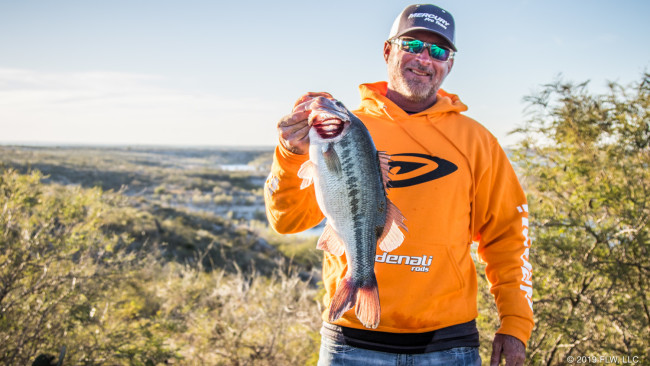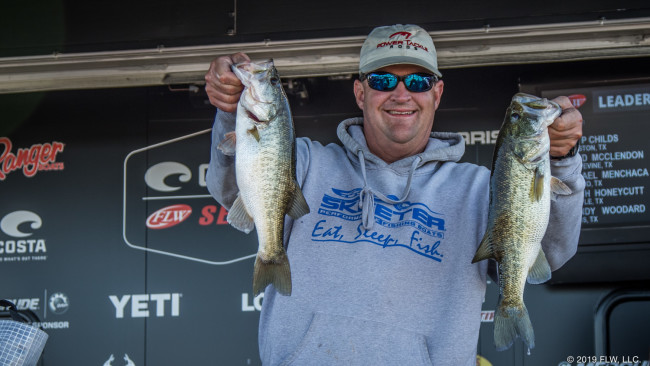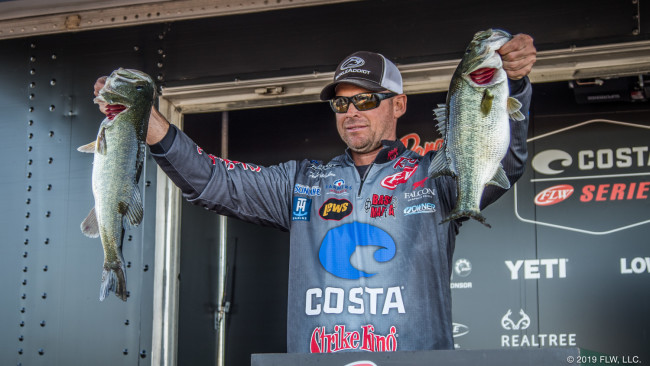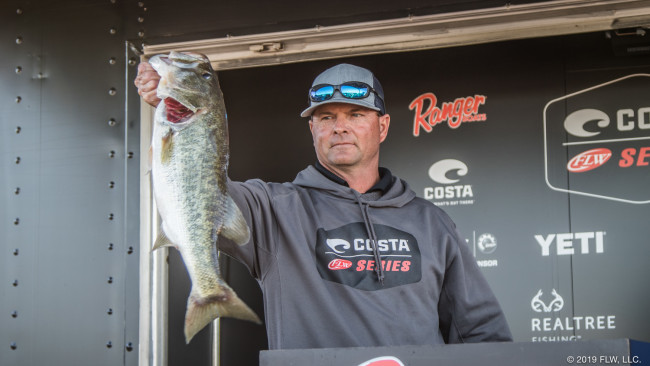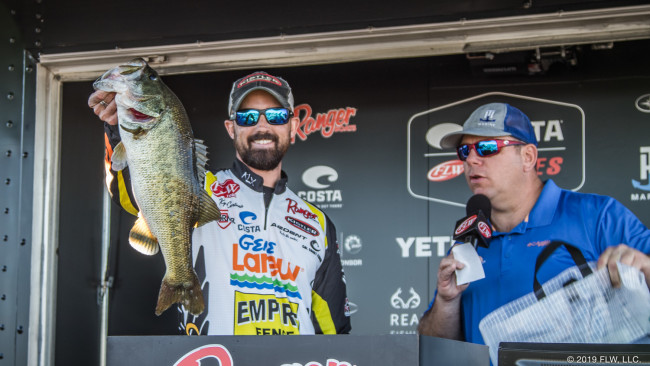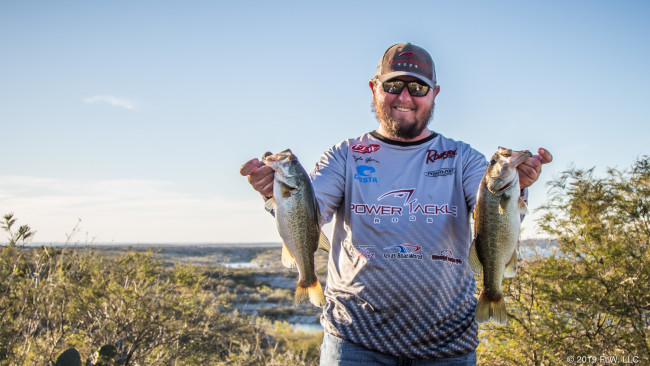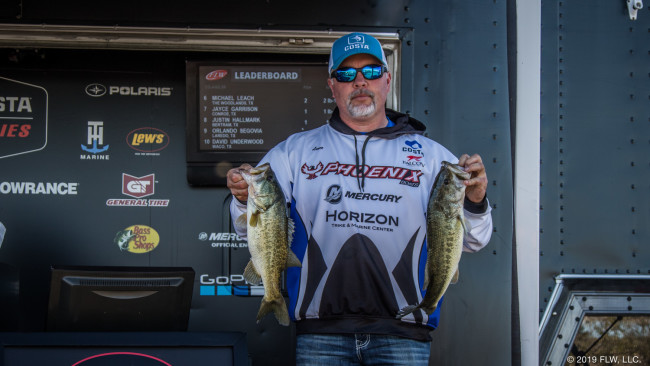Top 10 Patterns from Lake Amistad
Deep grass and drains were the primary targets
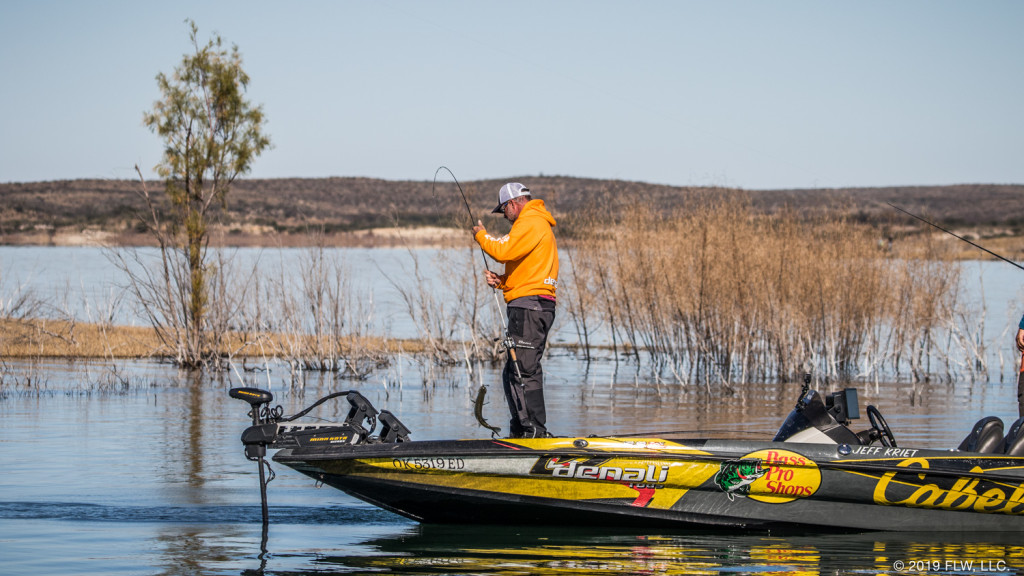
Lake Amistad was a bit of a fickle playing ground for the Costa FLW Series Southwestern Division opener presented by Ranger Boats. Local stick Ray Hanselman spent his entire tournament in a prespawn staging area where he patiently picked his way through a handful of key stretches. Grass height was key, and Hanselman was able to leverage what he called a biomass of fish for a huge first-day lead that he’d expand into a 38-pound tournament total and a whopping margin of victory.
Hanselman caught most of his fish on a Strike King 5XD and a jerkbait. With tougher conditions the final morning, he added a drop-shot to the mix. (The event was shortened to two days after extreme weather forced tournament directors to cancel the first day.)
Click here to read more about Hanselman’s winning pattern. Read on for details of the rest of the top 10.
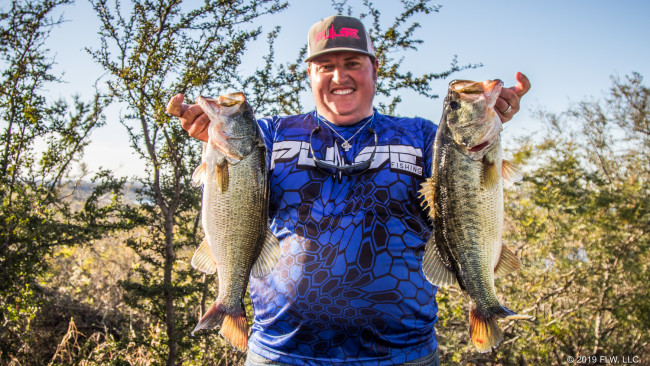
2. Umbrella rig key for second-place pro Patrick
Tyson Patrick knew what he had to do, and he made no apologies for doing it. Committing to an umbrella rig – the multi-arm presentation that draws groaning disapproval from some anglers – the McCamey, Texas, pro turned in limit catches of 10-3 and 15-12 to take the runner-up spot with 25-15.
“Once that water gets down into the low to mid-50s, it starts picking up for me,” Patrick says of the umbrella rig bite. “I was catching them on rocky points with a bluff wall up the Rio Grande River. I was sitting in about 35 feet of water and catching them in about 10.
“You could see the fish right above the [submerged] trees, so I’d just count it down about two seconds and then start slow-rolling it.”
Patrick credits a Power Tackle swimbait rod for the ability to launch the Hog Farmer umbrella rig. He fitted his rig with Keitech swimbaits, using 1/8-ounce heads on the bottom wires and a 3/8-ounce head in the target position.
“I used the electric chicken-color swimbaits,” Patrick says. “That just seemed to work best for me in that dingier river water.”
As Patrick notes, he fished the same spots on day two as he fished on the first day, but an early morning breeze helped stimulate his fish the second day. Also important was side scanning for bait pods and fishing around these buffets.
3. Kriet works grassy drains for third
Following a fifth-place performance of 14-6 on the first day, Jeff Kriet added 10-14 on Saturday to finish third with 25-4. The pro from Ardmore, Okla., says he found plenty of fish in the final round, but the activity level was markedly lower.
“The last day was weird because I saw a lot more fish on the graph, but they were just flat-lining. They weren’t moving, and when they’re not moving you’re not going to catch them,” Kriet says. “I kept running the same stuff, thinking they would bite, but I had a hard time and only caught eight keepers.”
Kriet caught most of his fish on a Cabela’s McClelland Competition Series Swimmer swimbait on a 1/4-ounce head and a drop-shot rigged with a Big Bite Baits Jeff Kriet Shaking Squirrel worm in the Kriet’s magic color.
“With the swimbait, I’d fish it right above the grass and just try to hit the top of the grass,” Kriet says. “I caught all my fish in deep grass on the sides. I never caught one on a point. I was keeping my boat between 18 and 23 feet. That’s where the best green hydrilla was.
“I’d just follow those drains, and every now and then I’d go over a little wad of them. I’d drop a waypoint, spin back around and fish for them for a little bit. About every third drain, I’d hit a little school of them.”
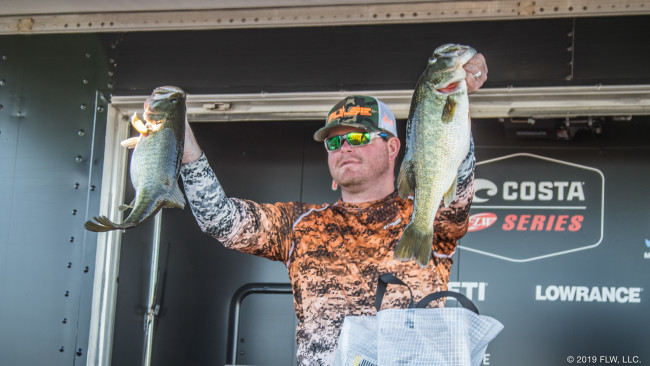
4. Swapping ledges for deep grass boosts Blaine up to fourth
One of the biggest movers of the tournament, William Blaine of San Angelo, Texas, placed 33rd on the first day with 8-6, but nearly doubled his effort a day later by sacking up 16-4 to finish fourth with 24-10.
Switching game plans from the first day, Blaine abandoned the ledge fishing and targeted fish in deep grass. His move paid big dividends, as he found both quality and quantity.
“I stayed there all day and caught every one of them I could,” Blaine says. “I probably caught four more limits that would have beat what I had yesterday [Friday].”
Fishing the mid-lake area, Blaine worked grass beds in 16 to 25 feet.
“I think my area was good because it didn’t look good on a map,” Blaine says of his unpressured sweet spot. “I didn’t see a boat all day because it wasn’t really something you’d look at.”
Blaine caught his fish on a diverse assortment of baits, including an umbrella rig with Reaction Innovations Skinny Dippers, a drop-shot with a green pumpkin Zoom Trick Worm and a 6th Sense swimbait.
5. Flowers follows drains for fifth
After placing third on the first day with 14-15, Tim Flowers struggled to find consistency in the final round and weighed only four fish for 8-9. Buoyed by the strong opening performance, the Midland, Texas, pro finished fifth with 23-8.
“I only fished five or six spots a day and tried to hit the high-percentage spots instead of running around and burning gas,” Flowers says. “My fish were coming from 18 to 22 feet in deep drains with grass. Sometimes there would be a high spot and there would be fish sitting on them.”
On the first day, Flowers was able to get some of his fish to bite a drop-shot, but he caught all of his final-day fish on a Wing Ding tail-spinner and a Megabass Deep-Six crankbait.
“A lot of times, when I’d throw the Wing Ding, I’d get a fish to fire, and if there was a school sitting there with it, I’d throw back in there and catch them with the crankbait,” Flowers says. “That happened on the final morning. I was sitting on one fish and pulled up in a good drain, caught a 3-pounder on the Wing Ding and threw back in there with the crankbait and caught a 2 1/2.”
6. Castledine mounts major comeback with crankbaits
After a dismal start with only two keepers for 4-12 left him in 76th place, Todd Castledine roared back with 18-7 – the final day’s biggest bag – and rose to sixth place with 23-3.
“I found these fish three weeks ago, and I only got to practice for three hours because I had been on vacation,” Castledine says. “I was on them, but I didn’t know there was a morning bite. The last morning, I went right to the sweet spot.
“It was a big, giant area and you could catch them everywhere, but when it got tough they moved to little-bitty spots. That last morning, I went right to it and had a limit in about 20 minutes, including my two biggest ones. I knew right there I was in check range, and I just kept plugging away and then had another one-hour window from 12 to 1 when I caught five or six.”
Castledine’s spot was a large area of grass on the Mexican side of the Rio Grande. With depths ranging from 5 to 20 feet, he caught his fish on a Strike King 5XD and a Strike King KVD 4.0 Magnum square-Bill square-bill.
7. Big bite lifts Andreas to seventh
For T.R. Andreas, the tournament’s first and second days followed the same game plan. The major difference was a 6-pound, 2-ounce final-round kicker that propelled him up from 19th place to seventh with a tournament total of 23-2.
“I caught over 40 fish yesterday [Friday], but I just didn’t get a big bite,” Andreas says. “I didn’t catch as many fish [on the last day], but the sun warmed the water and the fish lifted up out of deeper water.”
Fishing grass edges in 25 to 30 feet, Andreas caught his fish on an umbrella rig carrying white Strike King 3.75 Rage Swimmers on 1/8- and 1/16-ounce heads and a drop-shot with a Zoom Finesse Worm in watermelon red magic. The latter yielded the big bite around 2:30 on Saturday.
Andreas says his forward-looking sonar proved invaluable for identifying opportunities and then watching fish react to his bait.
“When the sun had warmed the water, I could see that the fish were about 8 feet from the top; they were up there sunning,” he says. “The fish were schooling and chasing shad. They were pushing that bait up against a wall of grass, and if you’re there at the right time, you’re going to catch them.”
8. Trees essential for Cortiana
Oklahoma pro Kyle Cortiana turned in a consistent performance with catches of 10-7 and 12-7, which lifted him to eighth place with 22-14. Essential to his success was a key piece of cover he located during practice.
“I had an underwater tree that you could put a deer stand in,” Cortiana says. “I was in 25 feet of water, and it had 10 feet of hydrilla next to it. I hooked one big fish there in practice, shook her off and caught her in the first three casts on the first day. It was a 6-11.
“I went back there today [Saturday] and threw plastics in there but couldn’t get bit. So I threw a jerkbait and caught another 6-pounder.”
After catching his tree fish, Cortiana says he ran the lake end-to-end. On the second day, he chased the wind and targeted banks exposed to the light breezes blowing across Amistad.
Cortiana’s top baits were a green pumpkin Gene Larew TattleTail Worm on a shaky head, a jerkbait, a Gene Larew Ned Rig Inch Worm in Minnesota flash on a Ned head and a chrome/olive back Bill Lewis Rat-L-Trap.
9. Glenn finesse fishes with drop-shot
After placing third on the first day with 14-15, Belton, Texas, pro Clyde Glenn found Amistad less generous in the final round. He came up one fish short of a limit but added 7-6 to finish ninth with 22-5.
“The first day, we had a little more wind first thing in the morning, and I was able to catch them,” Glenn says. “On this lake, when the wind doesn’t blow, they just don’t bite well.”
Glenn caught his day-two fish on a drop-shot with a watermelon red magic Zoom Salty Super Fluke Jr. and 8 1/2-pound-test Sunline fluorocarbon.
Fishing 15 to 20 feet of water, Glenn targeted patches of hydrilla. Patience was the key to his presentations.
“You’d make a cast, let it go to the bottom, take out your slack, and just hold it and wait,” he says. “I was counting 30 to 40 seconds at times and barely moving it. The fish were just barely tapping it.”
10. Deep jerkbait action puts Crawford in 10th
Oklahoma pro Lance Crawford placed sixth on the first day with 13-11, but a slower final day yielded only a small limit of 7-7. He ended in 10th with a tournament total of 21-2.
Crawford started each morning with jerkbaits, alternating between a Smithwick Perfect 10 Rogue and a Megabass Vision 110+1 in Table Rock shad color. The key, he says, was a patient presentation in deep water.
“I was sitting in 60 feet of water and throwing up shallow over a break in about 30 feet,” he says. “I was throwing up to about 15 feet and working it as deep as I could. You had to let it sit a long time once you got it deep.
“I caught most of my fish early on the Megabass jerkbait, and later in the day I had to go to the Rogue. It was like the water was 40 degrees, the way they’d hit it. You’d have to leave it sitting there, drink a pop and wait on them.”
